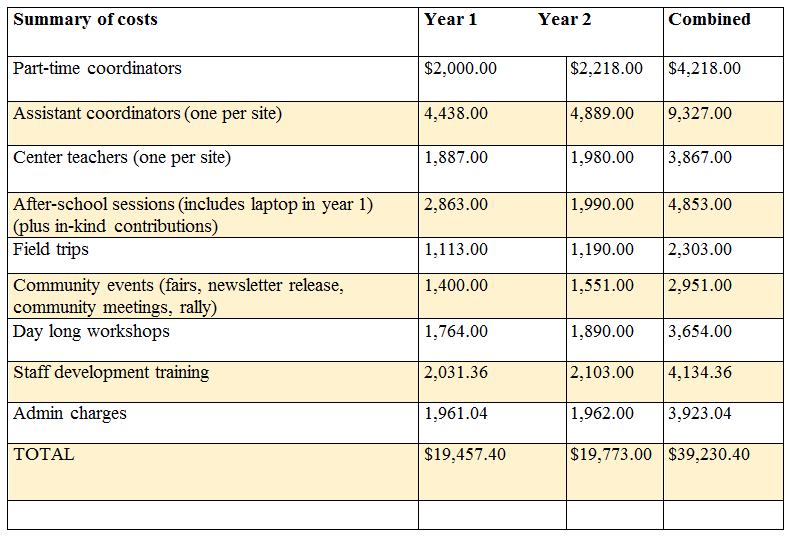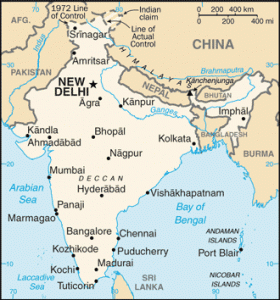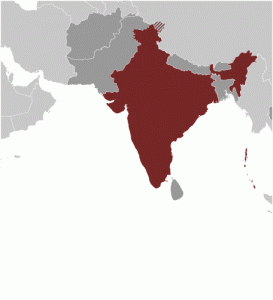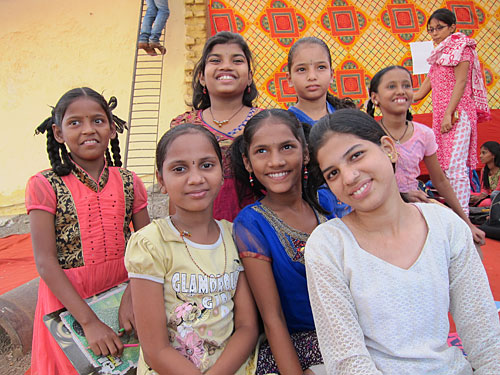
Mission
‘Vacha’ means speech, articulation and self-expression. Vacha envisions a world without exploitation, oppression, discrimination and injustice against women. Its mission is to empower girls and sensitize boys to become adults who value equality and become productive citizens.
Life Challenges of the Women Served
In India, girls – especially those who are poor, of lower castes, or who belong to linguistic or religious minorities – are routinely deprived of their education, health and basic rights. Their situation gets worse once they reach puberty. Between the ages of 10 – 18, marginalized families curtail the freedom and mobility of girls and restrict them to the private domain of the home. As a result, the world for these girls becomes limited to their immediate homes and basti (slums) and they lose access to knowledge and opportunities making them high-risk for dropping out of school, being forced into marriage, domestic violence, child labor and trafficking.
A 2013 report by the UN Development Program showed that only 27 percent of Indian women over 25 years of age had received a secondary education, compared to 50 percent of men. Because of this, only 29 percent of Indian women above the age of 15 are a part of the country’s formal labor force, compared to 81 percent of men. Girls who are removed from school and the public realm, and who do not have the skills to negotiate for their own lives, often find themselves forced into early marriage by their families and their community.
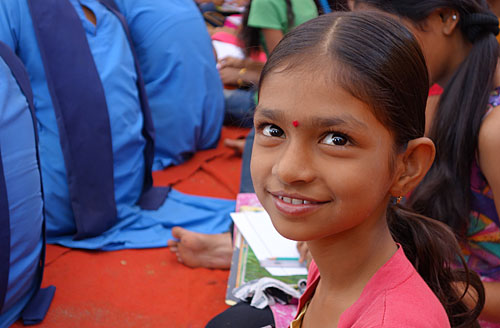 In India, 47 percent of girls under the age of 18 are married. For other girls, economic circumstances in their homes might mean that when they reach puberty they are sold into labor or the sex trade. Nearly 13 million workers in India are under age 14 and 43 percent of India’s sex workers are under age 16. When girls are denied the right to an education, denied access to knowledge and opportunities, denied their voice, not only do they suffer, but the cycle of poverty and violence against women continues.
In India, 47 percent of girls under the age of 18 are married. For other girls, economic circumstances in their homes might mean that when they reach puberty they are sold into labor or the sex trade. Nearly 13 million workers in India are under age 14 and 43 percent of India’s sex workers are under age 16. When girls are denied the right to an education, denied access to knowledge and opportunities, denied their voice, not only do they suffer, but the cycle of poverty and violence against women continues.
Vacha works with adolescent girls 10 – 18 years of age, living in basti in Mumbai and surrounding areas. These girls face discrimination on many fronts: based on gender, because they are poor, because of their status as migrants and/or because of they are part of linguistic (non-Marathi speaking) or religious minorities (non-Hindu). Their parents are migrants who work as menial labor or as daily wageworkers, earning less than $1.36 a day. These girls live in poor living conditions where ventilation and space are extremely limited. They live in small rooms and girls have to use public toilets, which have safety and hygiene issues.
Most of the girls Vacha works with are first generation learners or their parents are school dropouts after class 4 or 7. The girls face extreme pressures to drop out of school after class 8 or 10 (when school tends to cost more) to get married or help out at home and/or help their parents with their work. The schools the girls attend are overcrowded, lack textbooks, have poorly qualified teachers and primarily focus on “rote learning.”
This problem is not just confined to the communities of Mumbai but is rampant throughout India, affecting marginalized girls in every state. This problem is so prevalent that one-third of the world’s child brides come from India. Even though India is seen as a rising economic powerhouse, in 2013 it was ranked 127th out of 187 nations for gender equality by the World Economic Forum. That report went on to say that, with the exception of Afghanistan, all countries in South Asia are a better place for women than India. Given that India is home to 20 percent of the world’s adolescent girl population, the magnitude of this problem has global implications.
The Project
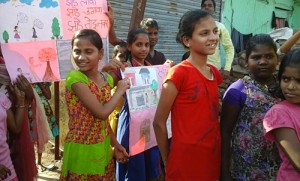 This project covers the first two years of a three-year implementation plan for two Girls Resource Centers (GRC) in Sanjay Gandhi Nagar, Jogeshwari (east) in Mumbai and in the Shelar Chauk community in the Kalyan Dombivali area on the outskirts of Mumbai. The project will follow a standard GRC curriculum model developed by Vacha based on decades of experience with 15 other GRCs. This model has been proven to build the skills girls from marginalized communities need to become active leaders in their communities and effect community change:
This project covers the first two years of a three-year implementation plan for two Girls Resource Centers (GRC) in Sanjay Gandhi Nagar, Jogeshwari (east) in Mumbai and in the Shelar Chauk community in the Kalyan Dombivali area on the outskirts of Mumbai. The project will follow a standard GRC curriculum model developed by Vacha based on decades of experience with 15 other GRCs. This model has been proven to build the skills girls from marginalized communities need to become active leaders in their communities and effect community change:
After-school sessions: Each week, Vacha will hold three, two-hour school sessions at each site for 100 – 120 girls. During these sessions, the girls will follow a structured skill-building curriculum that Vacha has developed over time.
That curriculum follows three core areas:
English: Girls will learn the alphabet, common words of daily use, parts of speech, simple tenses, and learn how to express themselves and converse in English in various situations, such as in a market, in school, for an interview, in a speech, etc.
Computers: Girls will learn how to use a computer, how to learn type in English and Hindi/Marathi, Microsoft Office and how to use the Internet. Some students will be enrolled in special classes to learn specific programs such as accounting software. The DFW budget includes the purchase one laptop in 2016 so the girls will have two laptops to share during these sessions. They will apply these skills by contributing to their community newsletter, developing PowerPoint presentations for public events and conducting Internet research on various social issues.
Leadership Skills: Girls will be lead through a series of educational and interactive sessions to understand the concept of rights and to learn about their basic rights to food, education, health and safety. They will learn how to bring notice to authorities about noncompliance related to basic rights. They will learn public speaking skills, how to conduct a community survey and videography/photography to help them advocate for their rights.
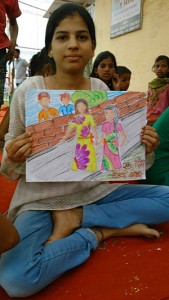 Workshops: Each year, each center will hold up to three daylong workshops to enable the girls to explore key issues such as nutrition, safety, basic rights and health. To “unlock” these issues, each workshop focuses on an artistic medium, such as drawing, photography, street theater, public speaking or print media, to activate the girls’ creativity to express and explore the topics. Vacha brings in technical experts (artists, photographers) to work with the girls during these sessions. Through these sessions, the girls lift up common themes and develop joint strategies to address the problems they face. These skills will enable them to express themselves in the public realm. By the end of the grant period, 70 percent of girls will have gained knowledge of their rights and 50 percent will have gained public speaking and expression skills.
Workshops: Each year, each center will hold up to three daylong workshops to enable the girls to explore key issues such as nutrition, safety, basic rights and health. To “unlock” these issues, each workshop focuses on an artistic medium, such as drawing, photography, street theater, public speaking or print media, to activate the girls’ creativity to express and explore the topics. Vacha brings in technical experts (artists, photographers) to work with the girls during these sessions. Through these sessions, the girls lift up common themes and develop joint strategies to address the problems they face. These skills will enable them to express themselves in the public realm. By the end of the grant period, 70 percent of girls will have gained knowledge of their rights and 50 percent will have gained public speaking and expression skills.
Community events/ Social Action: Vacha will help the girls identify and organize community events and social actions to spread awareness about key issues in their community and about their rights. Over the two-year grant period, at each center students will participate in up to three rallies, public meetings, letter writing campaigns to government authorities, photography exhibits, street theater and/or public speeches to raise awareness on gender, health and empowerment issues.
Field trips: The girls participating in Vacha’s programs come from the most disadvantaged families of the society and therefore lack any exposure to the world outside. The girls are prohibited from going anywhere but their school, relatives’ houses and their home villages. Exposing them to a greater world beyond their slums, especially to the different government facilities and cultural resources that are available to them, empowers them and helps them become more independent. Each center will conduct up to three field trips a year to places such as the local health post, the local police station, the area post office, the nearest railway station, the library or the Nehru Science Center.
Staff development workshops: Twice a year, Vacha will hold daylong staff workshops to revisit staff values and principles of work as well as brainstorm together and acquire new skills.
Millennium Development Goals
![]()
![]()
![]()
![]()
![]()
![]()
Questions for Discussion
- The girls from Mumbai think they can change the world because they have new skills and ideas. What would you tell them?
- How will educating girls affect the thinking of men and boys around them?
- Why is it important to keep girls from marrying before 18 and waiting just 2 years?
How the Grant Will be Used
The project budget includes:
- After-school sessions (materials for 100 girls)
- Field trips (transportation, venue tickets, and refreshments)
- Community events (materials and tools to make presentations)
- Day-long workshops (materials, logistics, meals)
- Staff Development Training (materials, logistics, lodging, meals)
- One laptop
Why We Love This Project/Organization
We love this project because of its focus on grassroots empowerment and advocacy programs to enable girls ages 10 – 18 to rise above their circumstances. Vacha will help the girls identify and organize community events and social actions and use creative mediums to engage the community and initiate change. By locating the programs within the girls’ communities, Vacha is ensuring buy-in from the community and building a more sustainable and successful model.
Evidence of Success
- Vacha girls have negotiated and at times also fiercely protested against early marriage of themselves or their relatives. In the past 4 years, 98 percent of Vacha girls have delayed marriage until after age 19 or 20.
- Vacha girls have successfully advocated at their homes for continuing education. In the last four years, 96 percent of the girls enrolled with Vacha have completed education until class 10, and around 50 percent have enrolled for university degrees.
- Vacha girls are participating in a range of campaigns to advance their rights. One such effort is the “Right to Pee” campaign that is working to ensure the city of Mumbai provides sufficient access to free and safe toilets for women. The campaign has successfully made the government announce that all toilets must be free to women and to increase the supply of public toilets throughout the city.
- In another effort, Vacha girls from a village in Thane sent letters to their elected village head complaining about a large garbage heap in their community. Within a week, the garbage was removed, trees were planted, and a sign was posted asking people to refrain throwing rubbish there.
- 23 percent of Vacha children have scored more than 75 percent in English in school exams compared to 3 percent of their peers.
- 96 percent of Vacha girls and boys have been trained to use digital technology compared to 39 percent of their peers.
Voices of the Girls
From Vacha students:
- “We need to change the attitudes of people who think that girls are good only for housework and raising children. [Show them] that girls can accomplish much more; that they can create an identity for themselves in society. I want to convince [these people] that, without us girls, the world will not make progress.”
- “Many girls [women] want to demand their rights but lack the financial resources to take recourse to the law. They are beaten up over dowry, even burned sometimes. Many times, because they can’t afford a lawyer, they choose to commit suicide. That is why I wish to become a lawyer and help get justice for girls and women.”
- “Vacha has helped me significantly with my education. They are the ones who taught me how to get educated and achieve our goals.”
- “The English Grammar that I learned at Vacha … the basic computer course … and the certificate of completion gave me a headway in securing a job.”
- “I never used to have any voice of my own, I was always a silent and timid person. After joining Vacha youth group, I have gained courage to speak in front of thousands and have enthused many more girls to follow my path.” – Supriya
About the Organization
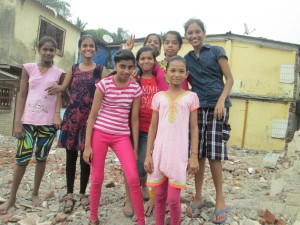 Vacha started in the 1980’s as an informal resource center to advance women’s rights. It was established and registered as a Trust in 1990 by a group of women activists. Since 1995 Vacha has focused on working with adolescent girls and boys in 17 slums centers in Mumbai, Thane and Valsad in Gujarat, with a special focus on girls. This shift in focus came with a deeper understanding that it was critical to work with adolescents as a preventive measure against the creation of vulnerabilities in women due to lack of education, exposure and opportunity. Vacha believes that empowered girls and sensitized boys have better chance of developing into adults who value equality and become productive citizens.
Vacha started in the 1980’s as an informal resource center to advance women’s rights. It was established and registered as a Trust in 1990 by a group of women activists. Since 1995 Vacha has focused on working with adolescent girls and boys in 17 slums centers in Mumbai, Thane and Valsad in Gujarat, with a special focus on girls. This shift in focus came with a deeper understanding that it was critical to work with adolescents as a preventive measure against the creation of vulnerabilities in women due to lack of education, exposure and opportunity. Vacha believes that empowered girls and sensitized boys have better chance of developing into adults who value equality and become productive citizens.
Vacha’s mission is to focus on issues of women and girls through educational programs, resource creation, research, training, campaigns, networking and advocacy. Vacha’s vision is of a world without exploitation, oppression, discrimination and injustice against women or any other section of society. These two centers give Vacha the scope and opportunity to work with two new groups (one Dalit/untouchable and one tribal/nomad) and reach more girls and their families to further their mission. Neither of these communities has an NGO working there focused on girls or gender. It is important to Vacha’s mission to reach out to communities or girls with no voice or previous interventions.
Where They Work
India’s diverse economy encompasses traditional village farming, modern agriculture, handicrafts, a wide range of modern industries, and a multitude of services. Slightly less than half of the work force is in agriculture, but, services are the major source of economic growth, accounting for nearly two-thirds of India’s output with less than one-third of its labor force.
India has capitalized on its large educated English-speaking population to become a major exporter of information technology services, business outsourcing services and software workers.
India has many challenges that it has yet to fully address, including poverty, corruption, violence and discrimination against women and girls, an inefficient power generation and distribution system, ineffective enforcement of intellectual property rights, decades-long civil litigation dockets, inadequate transport and agricultural infrastructure, limited non-agricultural employment opportunities, high spending and poorly-targeted subsidies, inadequate availability of quality basic and higher education, and accommodating rural-to-urban migration. Despite pressing problems, economic growth following the launch of economic reforms in 1991 and a massive youthful population are driving India’s emergence as a regional and global power.
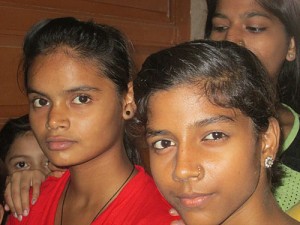 The Huffington Post reported in March of 2013, that about one in six Indian city residents lives in an urban slum with unsanitary conditions that are “unfit for human habitation,” according to the first complete census of India’s vast slum population. More than 40 percent of households in Mumbai, India’s financial capital and largest city with 19 million people, are located in overcrowded shantytowns where most residents are squatting illegally and many have little access to basic sanitation.
The Huffington Post reported in March of 2013, that about one in six Indian city residents lives in an urban slum with unsanitary conditions that are “unfit for human habitation,” according to the first complete census of India’s vast slum population. More than 40 percent of households in Mumbai, India’s financial capital and largest city with 19 million people, are located in overcrowded shantytowns where most residents are squatting illegally and many have little access to basic sanitation.
According to the CIA Factbook, the seventh largest country has a population of 1.3 billion as of 2015 and most of them speak Hindi (41 percent). The other languages are: Bengali 8.1 percent, Telugu 7.2 percent, Marathi 7 percent, Tamil 5.9 percent, Urdu 5 percent, Gujarati 4.5 percent, Kannada 3.7 percent, Malayalam 3.2 percent, Oriya 3.2 percent, Punjabi 2.8 percent, Assamese 1.3 percent, Maithili 1.2 percent and 5.9 percent speak some other language. English is the subsidiary official language but is the most important language for national, political and commercial communication.
The country is bordered by Pakistan, China, Nepal, Bangladesh, Myanmar (Burma) and Bhutan, as well as the Arabian and Laccadive Seas and the Bay of Bengal. Mumbai is on the Arabian Sea near the center of India’s west coast.
Sources: Vacha, US CIA Factbook, Huffington Post 3/3/15
A Closer Look
Adolescent girls from the slums of Mumbai occupy an unenviable place in Indian society – marginalized individuals within a marginalized community. Facing the same barriers of grinding poverty and systemic discrimination as their neighbors, girls from Mumbai’s poorest districts are further disadvantaged by pervasive gender inequality. The constraints of societal expectations can be limiting for adolescent girls, who often lack both the vision to imagine their lives being any different and the skills to effect change.
Such girls might be surprised to know how important their well-being is to the rest of the world. In fact, the United Nations Development Group has declared that “improving the lives of adolescent girls has a catalytic effect on society at large and contributes to poverty alleviation and gender equality and builds the foundation for their future roles and influence in the home, community, and society.” (1) In seeking to improve the lives of girls, the UNDG has included promoting adolescent girl leaders as one of its target areas.
Vacha Charitable Trust demonstrates its own commitment to this goal through its leadership programs for the girls of the Mumbai slums. These programs prepare girls to advocate for themselves and their communities. However, in a society that doesn’t always value the views of women, helping the girls feel comfortable about speaking out at all is vital to the program’s success.
One innovative approach Vacha has taken is integrating creative expression and advocacy, empowering the girls to share their opinions through performance and visual art. Expressing themselves through song, dance, photography or drama gives girls socially acceptable visibility, reaching a public audience without breaking cultural rules. (2) “Vacha Girls” have tackled thorny tasks like raising awareness on the effects of sexual harassment by creating poster exhibitions, newsletters and street theater productions. Other programs for women in the developing world have also enjoyed tremendous success with artistic forms of community education and advocacy, from street theater in Nepal aimed at reducing child marriage to African women mobilizing for farming reform through dramatic performances. (3)
While creative expression has proven to be an effective tool for change, it also helps the girls themselves. Through Vacha’s program, girls learn about public speaking and using technology. The artistic aspects of the program build communication skills and self-esteem. “Theatre work,” declares UNICEF, “enhances talents in writing and performing. It encourages children to articulate their ideas and gives them confidence to express them.” (4) Performing for an audience gives the girls public approval for the first time in their lives. A United Nations spotlight series on the benefits of community theatre for disadvantaged kids describes one organization’s “light bulb moment” when street children “performed, were applauded, and seen in a positive light by the broader community…When they were celebrated, the youth recognized their own importance and voice.” (5)
Public exhibits and performances that reach beyond local audiences have the potential to make a difference in a community by getting the attention of decision-makers. In discussing creative projects aimed at allowing girls to remain at school, the United Nations Girls’ Education Initiative stressed the importance of creative expression in influencing policy: “Film is an innovative advocacy tool for girls’ education, changing minds and inspiring action by allowing people to see and hear from girls themselves.” (6)
Source Materials
Sources: 1) United Nations Development Group 2) Development Leadership Program 3) United Nations Population Fund and Malawi and Mozambique 4) UN Children’s Fund 5) UN’s C4D 6) United Nations Girls’ Education Initiative

